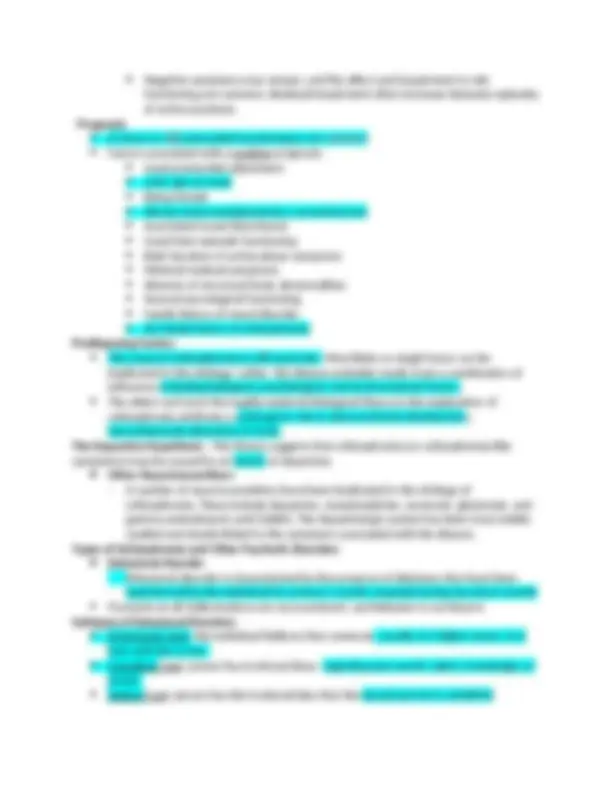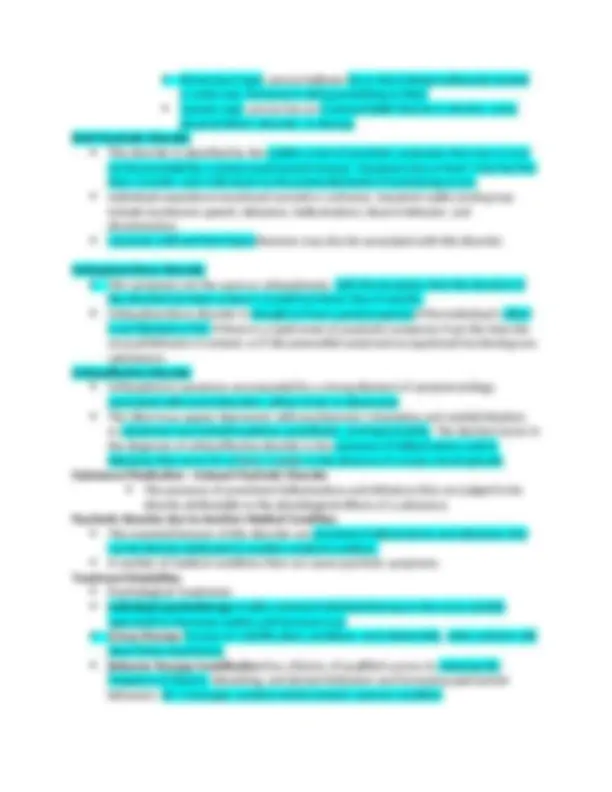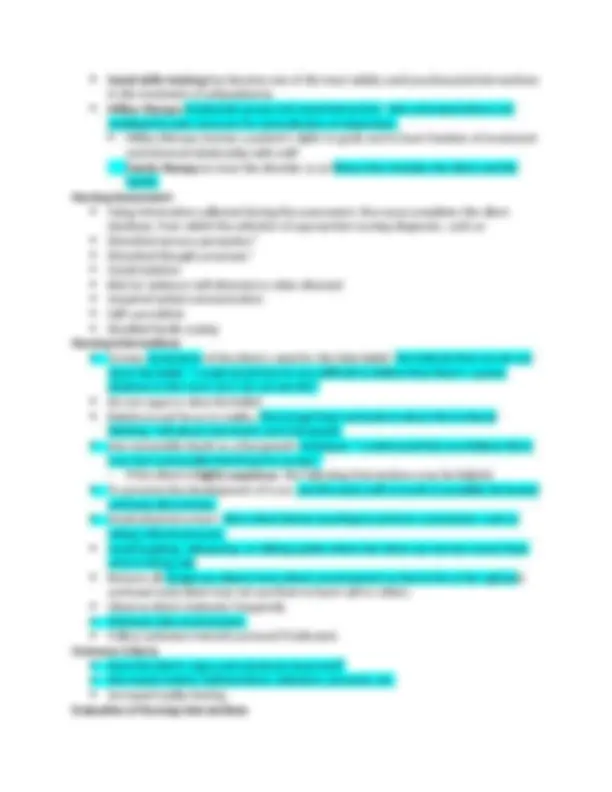





Study with the several resources on Docsity

Earn points by helping other students or get them with a premium plan


Prepare for your exams
Study with the several resources on Docsity

Earn points to download
Earn points by helping other students or get them with a premium plan
Community
Ask the community for help and clear up your study doubts
Discover the best universities in your country according to Docsity users
Free resources
Download our free guides on studying techniques, anxiety management strategies, and thesis advice from Docsity tutors
A comprehensive overview of schizophrenia spectrum and other psychotic disorders, including their definition, symptoms, phases, predisposing factors, types, and treatment modalities. It covers the various stages of the disorder, from the premorbid phase to the residual phase, and highlights the importance of early intervention and a multidisciplinary approach to treatment. The document also discusses the potential for suicide, the impact on social and occupational functioning, and the factors associated with a positive prognosis. Additionally, it delves into the nursing assessment and interventions required to manage these complex mental health conditions. This detailed information can be valuable for healthcare professionals, students, and individuals seeking to understand the complexities of schizophrenia spectrum and other psychotic disorders.
Typology: Lecture notes
1 / 6

This page cannot be seen from the preview
Don't miss anything!




Exam 2 Chapter 24 Schizophrenia Spectrum and Other Psychotic Disorders Introduction § Schizophrenia spectrum and other psychotic disorders include: schizophrenia, other psychotic disorders, and schizotypal (personality) disorder. They are defined as abnormalities in one or more of the following 5 domains: delusions, hallucinations, disorganized thinking (speech), grossly disorganized or abnormal motor behavior (including catatonia, and negative symptoms). There is NO cure § Various definitions of the disorder have evolved, and numerous treatment strategies have been proposed, but none have proven to be uniformly effective or sufficient. § Potential for suicide is a major concern among patients with schizophrenia. About one- third of people with schizophrenia attempt suicide and about 1 in 10 die from the act. § Characteristically, disturbances in thought processes, perception, and affect invariably result in a severe deterioration of social and occupational functioning. § Symptoms generally appear in late adolescence or early adulthood, although they may occur in middle or late adult life, STARTS IN 16-17 YEARS BUT MANIFEST IN EARLY 20’S § Effective treatment requires a comprehensive, multidisciplinary effort, including pharmacotherapy and various forms of psychosocial care, such as living skills and social skills training, rehabilitation and recovery, and family therapy. We want to start care quickly. Once it has progressed to a certain level, it has poor prognosis. If we catch early, it wont be that bad § Of all the mental illnesses that cause suffering in society, schizophrenia probably is responsible for lengthier hospitalizations, greater chaos in family life, more exorbitant costs to individuals and governments, and more fears than any other (due to their behavior, but they are responding to internal stimuli not to us, they are very fearful and are paranoid cause they think someone is trying to harm then) Nature of the Disorder § Psychosis is a severe mental condition in which there is disorganization of the personality, deterioration in social functioning, and loss of contact with, or distortion of, reality. There may be evidence of hallucinations and delusional thinking. § Psychosis can occur with or without the presence of organic impairment. (ex: using drugs= biological process) Phases of Schizophrenia § The pattern of development of schizophrenia may be viewed in four phases : the premorbid phase, the prodromal phase, the active psychotic phase (schizophrenia), and the residual phase. Phase I – Premorbid Phase § The premorbid personality often indicates social maladjustment, social withdrawal, irritability, and antagonistic thoughts and behavior. Antagonistic behavior: going against, very negative
§ Signs and symptoms include: shyness, passivity, introversion, minimal friends/peer relationships, poor school performance, anti-social behaviors and a preference for solitary activities. Become isolated, poor self-esteem, embarrassment Phase II – Prodromal Phase § The prodrome of an illness refers to certain signs and symptoms that precede the characteristic manifestations of the acute, fully developed illness and lasts from a few weeks to a few years (average length is 2-5 years). If they stop taking med, they will be worst than when they were admitted. EX: feeling as furniture was dissolving and bugs were on him § Signs and symptoms include : Deterioration in role functioning and social withdrawal, substantial functional impairment, sleep disturbance, anxiety, irritability, depressed mood, poor concentration, fatigue, perceptual abnormalities, ideas of reference, and suspiciousness herald onset of psychosis. § Recognition of the behaviors associated with the prodromal phase provides an opportunity for early intervention with a possibility for improvement in long-term outcomes. § Current treatment guidelines suggest therapeutic interventions that offer support with identified problems, cognitive therapies to minimize functional impairment, family interventions to improve coping, and involvement with the schools to reduce the possibility of failure. Phase III - Schizophrenia § The Diagnostic and Statistical Manual of Mental Disorders, Fifth Edition (DSM-5) (American Psychiatric Association [APA], 2013) diagnostic criteria for schizophrenia:
§ Persecutory type: person believes he or she is being maliciously treated in some way. Everyone is doing something to them § Somatic type: person has an irrational belief that he or she has some physical defect, disorder, or disease. Brief Psychotic Disorder § This disorder is identified by the sudden onset of psychotic symptoms that may or may not be preceded by a severe psychosocial stressor. Symptoms last at least 1 day but less than 1 month, and a full return to the premorbid level of functioning occurs. § Individuals experience emotional turmoil or confusion. Impaired reality testing may include incoherent speech, delusions, hallucinations, bizarre behavior, and disorientation. § Catatonic (still and then hyper)features may also be associated with this disorder. Schizophreniform Disorder § The symptoms are the same as schizophrenia, with the exception that the duration of the disorder has been at least 1 month but fewer than 6 months. § Schizophreniform disorder is thought to have a good prognosis if the individual’s affect is not blunted or flat, if there is a rapid onset of psychotic symptoms from the time the unusual behavior is noticed, or if the premorbid social and occupational functioning was satisfactory. Schizoaffective Disorder § Schizophrenic symptoms accompanied by a strong element of symptomatology associated with mood disorders, either manic or depressive. § The client may appear depressed, with psychomotor retardation and suicidal ideation, or symptoms may include euphoria, grandiosity, and hyperactivity. The decisive factor in the diagnosis of schizoaffective disorder is the presence of hallucinations and/or delusions that occur for at least 2 weeks in the absence of a major mood episode. Substance/Medication - Induced Psychotic Disorder § The presence of prominent hallucinations and delusions that are judged to be directly attributable to the physiological effects of a substance. Psychotic Disorder due to Another Medical Condition § The essential features of this disorder are prominent hallucinations and delusions that can be directly attributed to another medical condition. § A number of medical conditions that can cause psychotic symptoms. Treatment Modalities § Psychological Treatments § Individual psychotherapy (reality-oriented individual therapy is the most suitable approach) to decrease anxiety and increase trust. § Group therapy focuses on real-life plans, problems, and relationship, other patients talk about their experiences § Behavior therapy/modification has a history of qualified success in reducing the frequency of bizarre, disturbing, and deviant behaviors and increasing appropriate behaviors. EX: a teenager, positive reinforcement: operant condition
§ Social skills training has become one of the most widely used psychosocial interventions in the treatment of schizophrenia. § Milieu therapy emphasizes group and social interaction; rules and expectations are mediated by peer pressure for normalization of adaptation. § Milieu therapy stresses a patient’s rights to goals and to have freedom of movement and informal relationship with staff.